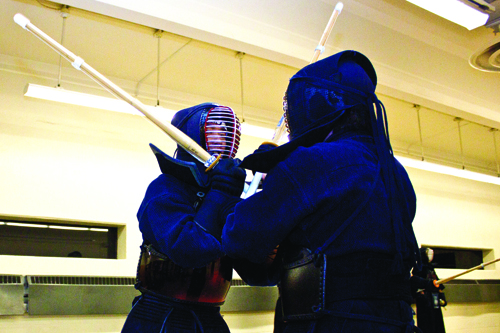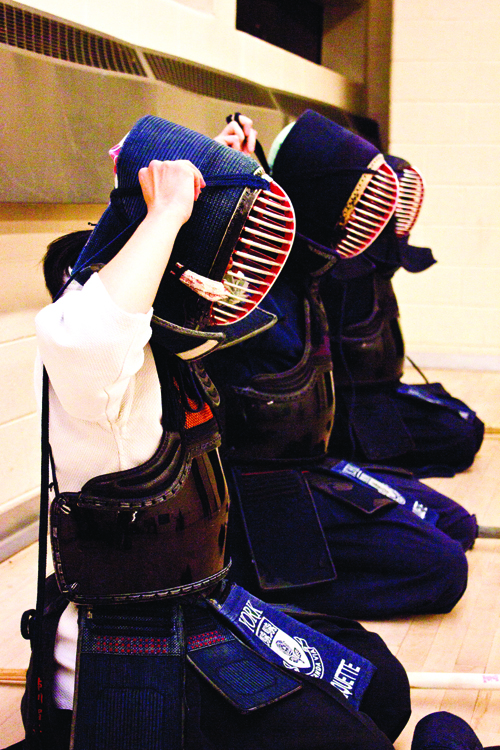Deyana Sameh, president of York’s club, talks to Excalibur about kendo’s rich history
Robert Weese
Contributor

War cries echoing through the room, and bamboo swords driving at people at a 100 miles per hour—York University Kendo Club’s practice looks more like a raging battlefield than a typical team practice.
Going into its 15th year, the kendo club has been training diligently all season to compete in the Canadian Kendo Federation’s annual intercollegiate tournament.
Kendo was established in Canada during World War II, when many Japanese immigrants were forced into internment camps due to the government’s fear of espionage and sabotage following Japan’s attack on Pearl Harbour. Thus, says Deyana Sameh, president of the club, they learned and practiced kendo.
“Once they were released from these camps, they continued and shared their passion with other Canadians who became interested,” she says.
The sport then spread all over Canada, and is currently most popular in Ontario and British Columbia.
Translating to “the way of the sword,” kendo originated in the samurai class of feudal Japan. The sport became popular in the late 18th century, when the swords and the armour were refined to lower the risk of severe injury and death during a match.
The swords, called shinai, were now made with bamboo instead of metal, which still allowed fighters to deliver strikes and thrusts to an opponent’s target area with full force, but reduced the chances of serious injury.
The armour, or bogu, based on traditional samurai armour, was also adapted with the goal of a less violent sport in mind. The word can be broken down into two parts: “bo,” which means to protect or defend, and “gu,” which means equipment or tool. The bogu is also worn with a robe underneath, called a hakama nagi.
A set of bogu has four components: men, which protects the face and shoulders (i.e. a form of helmet); kote, which protects the hand and forearm; do, a torso protector; and finally the tare, which are groin and leg protectors.
Each piece of armor has a target area that fighters try to exploit during a match to earn marks or points. For the men, it is the centre top, and upper left and right sides for cutting strike moves, and the centre of the throat protector for a thrust; for the kote, it is the wrist portion of each kote protector; for the do, they are the two lower sides of the torso which fighters can hit with a slashing cut to the stomach region; and lastly, the tare has no target areas but it offers protection against off-target and accidental strikes.
To win a match, a competitor must earn two points or have the highest score once the time is up.
 Prior to the start of a match, both kendokas bow to the instructors, or sensei, and to each other out of mutual respect; upon conclusion, they bow to the dojo, the arena, as if to say, “Thank you for all of this.”
Prior to the start of a match, both kendokas bow to the instructors, or sensei, and to each other out of mutual respect; upon conclusion, they bow to the dojo, the arena, as if to say, “Thank you for all of this.”
The club meets weekly for practices, which consist of drills for both beginners and advanced members who are already certified to fight with armor.
Sameh emphasizes the importance of respect and discipline in kendo, whether it is during practice or in
a tournament.
“Etiquette is very important in kendo,” she says. “The etiquette to both your opponent and the sensei [is what] we try to teach to our beginning members.”
Sameh says while it’s difficult to be a competitive club, with transportation and equipment fees coming out pocket, they are not interested in reaching varsity status.
“We would have to change every university kendo club, and have them become varsity as well,” she says. “It’s not really something we’re working towards. We are happy where we are.”
The club has already started to prepare for the annual intercollegiate Kendo tournament in January, which York is hosting this year. The club has set their sights on winning the Sumarai Cup, the most prestigious award for students, having narrowly missed the award in the past.
Samed has her eye on the prize.
“This year, we’ve been training really hard, so we’re hoping to get first place and get the trophy.”


